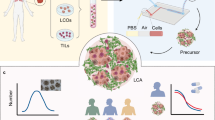Abstract
This study highlights the usefulness of laser scanning confocal microscopy in the examination of subcellular disposition of anthracyclines in tumour cell lines. The distribution of anthracycline compounds has been studied in two pairs of parental and multidrug resistant (MDR) cell lines. For the parental EMT6 mouse mammary tumour cell line EMT6/P treated with doxorubicin (DOX) the anthracycline fluorescence was shown to be predominantly nuclear but with some particulate cytoplasmic fluorescence and very low levels of plasma membrane staining. In the same experiments much fainter fluorescence was seen for the EMT6/AR1.0 MDR subline which hyperexpresses P-glycoprotein. The loss of nuclear fluorescence was comparatively greater than loss of cytoplasmic fluorescence. For the human large cell lung cancer line COR-L23/P cellular DOX disposition was markedly nuclear with nuclear membrane staining and diffuse cytoplasmic fluorescence. For the MDR line COR-L23/R, which lacks P-glycoprotein expression, DOX fluorescence was reduced in the nucleus compared with the parental line, but an intense area of perinuclear staining was seen consistent with localisation to the Golgi apparatus. The morpholinyl-substituted analogue MR-DOX achieved very similar subcellular distribution in both parental and MDR lines, consistent with its retention of activity in the latter. The presence of verapamil during anthracycline exposure increased the intensity of fluorescence in the MDR lines, particularly in the nucleus. Relatively little effect was seen in the parental lines. Confocal microscopy provides high resolution images of the subcellular distribution of anthracyclines in parent and MDR cell lines. Differences in drug disposition in various cell lines may provide insights into the mechanism of multidrug resistance and suggest strategies for its therapeutic circumvention.
This is a preview of subscription content, access via your institution
Access options
Subscribe to this journal
Receive 24 print issues and online access
$259.00 per year
only $10.79 per issue
Buy this article
- Purchase on Springer Link
- Instant access to full article PDF
Prices may be subject to local taxes which are calculated during checkout
Similar content being viewed by others
Author information
Authors and Affiliations
Rights and permissions
About this article
Cite this article
Coley, H., Amos, W., Twentyman, P. et al. Examination by laser scanning confocal fluorescence imaging microscopy of the subcellular localisation of anthracyclines in parent and multidrug resistant cell lines. Br J Cancer 67, 1316–1323 (1993). https://doi.org/10.1038/bjc.1993.244
Issue Date:
DOI: https://doi.org/10.1038/bjc.1993.244
This article is cited by
-
Role of autophagy and lysosomal drug sequestration in acquired resistance to doxorubicin in MCF-7 cells
BMC Cancer (2016)
-
Strategies for advancing cancer nanomedicine
Nature Materials (2013)
-
LASS2 enhances chemosensitivity of breast cancer by counteracting acidic tumor microenvironment through inhibiting activity of V-ATPase proton pump
Oncogene (2013)
-
Role of aldo-keto reductases and other doxorubicin pharmacokinetic genes in doxorubicin resistance, DNA binding, and subcellular localization
BMC Cancer (2012)
-
Drug penetration in solid tumours
Nature Reviews Cancer (2006)



